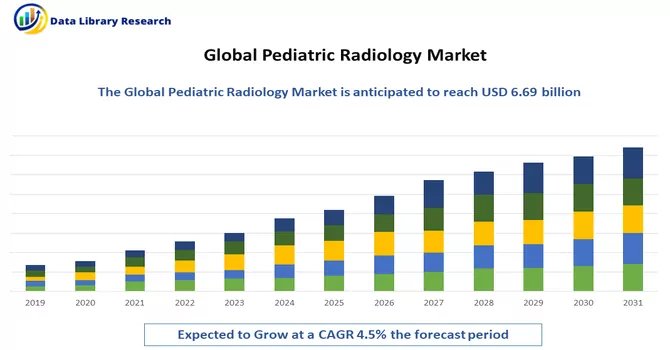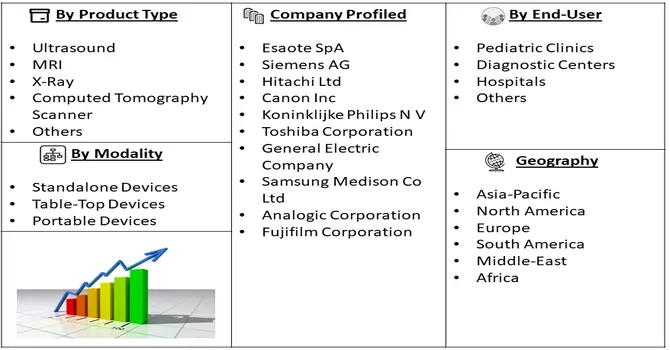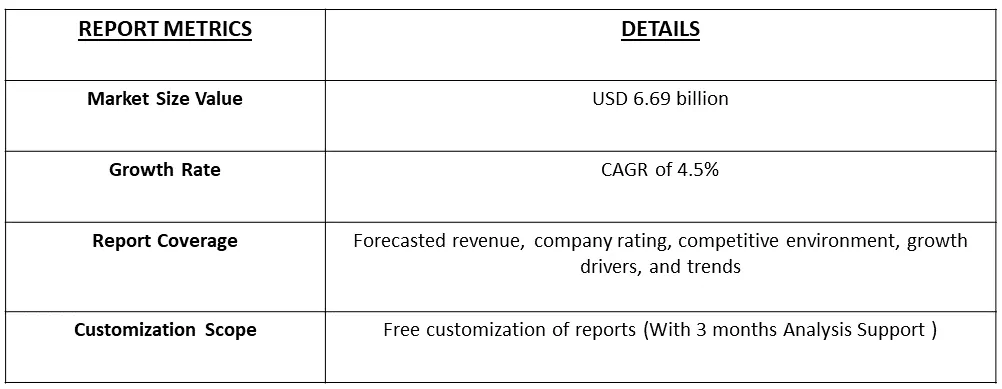The pediatric radiology market studied is valued at USD 6.69 billion in the year 2023 and is expected to reach USD 8.33 billion by the year 2031, registering a CAGR of 4.5% during the forecast period.

Get Complete Analysis Of The Report - Download Free Sample PDF
Pediatric radiology is a specialized branch of radiology that focuses on the imaging and diagnosis of diseases, disorders, and injuries in infants, children, and adolescents. Radiology is a medical specialty that uses various imaging techniques to visualize the internal structures of the body and aid in the diagnosis and treatment of medical conditions. In pediatric radiology, imaging techniques such as X-rays, ultrasound, computed tomography (CT), magnetic resonance imaging (MRI), and nuclear medicine are employed to examine the anatomy and function of organs and tissues in pediatric patients. These imaging studies help healthcare professionals, including pediatric radiologists, pediatricians, and other specialists, to diagnose a wide range of conditions in children, including congenital abnormalities, developmental disorders, infections, injuries, and tumors. Pediatric radiologists are trained to understand the unique aspects of imaging in children, considering their smaller size, developmental stages, and the need to minimize radiation exposure. The goal of pediatric radiology is to provide accurate and timely diagnostic information while ensuring the safety and well-being of the pediatric patients.
The driving factors in the field of pediatric radiology are influenced by the unique characteristics and healthcare needs of children. Pediatric radiology is propelled by several key factors aimed at addressing the distinct healthcare requirements of children. Tailored to the unique anatomical and physiological characteristics of pediatric patients, this specialized field prioritizes early detection and diagnosis of conditions, ranging from congenital abnormalities to developmental disorders. Crucially, pediatric radiology places a strong emphasis on minimizing radiation exposure, recognizing the heightened sensitivity of children to such exposure. Collaborating with various medical specialists, including pediatricians and surgeons, ensures a multidisciplinary approach, fostering comprehensive care for young patients. Advances in imaging technologies, such as high-resolution MRI and digital radiography, continually enhance diagnostic capabilities, contributing to improved patient outcomes.
Market Segmentation: The Pediatric Radiology Market report is segmented by Product Type (Ultrasound, MRI, X-Ray, Computed Tomography Scanner, and Others), Modality (Standalone Devices, Table-Top Devices, and Portable Devices), End-User (Pediatric Clinics, Diagnostic Centers, Hospitals, and Others), and Geography (North America, Europe, Asia-Pacific, Middle East and Africa, and South America). The report offers the value (in USD million) for the above segments.

For Detailed Market Segmentation - Download Free Sample PDF
The trend towards remote work, accelerated by advancements in communication technologies, has given rise to hybrid work models, transforming traditional notions of the workplace. In healthcare, technology is driving advancements in telemedicine and digital health solutions, while the emphasis on cybersecurity has heightened across industries in response to increasing cyber threats. The global push for a greener future is evident in the rising investments in renewable energy sources. Supply chain resilience is a focal point, with companies reevaluating and diversifying supply chains to mitigate vulnerabilities exposed by the COVID-19 pandemic. The financial sector is witnessing the rise of decentralized finance (DeFi), leveraging blockchain technology to offer financial services without traditional intermediaries. Finally, there is a growing commitment to promoting diversity, equity, and inclusion in the workplace, as businesses recognize the importance of fostering inclusive environments and addressing systemic inequalities. These trends collectively underscore the transformative forces shaping the business landscape and highlight the need for adaptability and innovation.
Market Drivers:
The Rising Prevalence of Pediatric Diseases and Conditions
The increasing incidence of pediatric diseases, encompassing conditions like congenital abnormalities, neurological disorders, and respiratory issues, serves as a catalyst for the heightened demand in pediatric radiology services. As the prevalence of these health challenges rises, there is a corresponding surge in the necessity for advanced diagnostic imaging procedures tailored to the unique medical needs of children. This escalating demand underscores the pivotal role of pediatric radiology in providing accurate and timely diagnoses for a spectrum of conditions affecting the pediatric population. An article published by Orphanet Journal of Rare Disease reported that diffuse parenchymal lung diseases (DPLD) in children represent a rare and heterogeneous group of chronic pulmonary disorders. Also, the article reported that the incidence of DPLD was 1.32 new cases per 1 million of children per year. Thus, such incidence report that the high incidence of these lung disorders may increase the demand for radiology services for paediatric patients, thereby contributing to the studied market’s growth.
Increased Awareness Among Healthcare Professionals, Parents, and Caregivers
The growing awareness among healthcare professionals, parents, and caregivers about the significance of early detection and precise diagnosis in pediatric healthcare is fostering an increased reliance on pediatric radiology. As understanding deepens regarding the importance of specialized imaging techniques for children, there is a heightened recognition of the role pediatric radiology plays in providing crucial insights into various medical conditions affecting the pediatric population. Healthcare professionals are becoming more attuned to the value of incorporating pediatric radiology into comprehensive care plans for children, recognizing its ability to offer non-invasive yet highly informative assessments. Parents and caregivers, armed with a greater understanding of the benefits and safety measures associated with pediatric radiology, are increasingly advocating for these advanced diagnostic services for their children. This heightened awareness is not only shaping attitudes toward early intervention but also driving a proactive approach to healthcare seeking for pediatric patients. The collaborative efforts of healthcare professionals, parents, and caregivers in embracing pediatric radiology contribute to improved healthcare outcomes for children by facilitating timely and accurate diagnoses, thereby laying the foundation for more effective treatment strategies. Thus, such factors are driving the growth of the studied market over the forecast period.
Market Restraints:
Reimbursement Challenges
The financial viability and expansion of pediatric imaging practices can be jeopardized by the presence of reimbursement policies for pediatric radiology services that are either inconsistent or insufficient. Inadequate reimbursement creates a significant challenge for healthcare providers, as it can impede their ability to cover the costs associated with pediatric imaging procedures. The financial strain arising from these limitations not only affects the sustainability of existing pediatric imaging services but also hampers the potential for growth and improvement in the quality of care provided to pediatric patients. Healthcare facilities heavily rely on reimbursement mechanisms to offset the expenses related to specialized equipment, skilled personnel, and the overall infrastructure required for pediatric radiology. When reimbursement policies fail to adequately compensate for these investments, healthcare providers may face financial constraints that limit their capacity to maintain, upgrade, or expand pediatric imaging services. This situation not only impacts the availability of cutting-edge technologies but may also contribute to potential delays in accessing timely and advanced diagnostic services for pediatric patients. Thus, such factors may slow the growth of the studied market over the forecast period.
The pediatric radiology market experienced a notable impact from the onset of the COVID-19 pandemic. A research article published in April 2020 by the Radiological Society of North America highlighted that measures implemented to curb the transmission of the virus led to a reduction in the demand for imaging services. The study, conducted during the pre-COVID-19 control era, revealed that 25.5% of 568 children had documented bone fractures in 669 imaging studies. In contrast, during the COVID-19 era, 44.6% of 177 pediatric patients displayed bone fractures in 193 imaging studies. Despite this initial downturn, the market was anticipated to recover its full potential in the coming years, propelled by the long-term effects of COVID-19 on the body and widespread vaccination efforts globally. The observed impact was significant, but with the easing of COVID-19 restrictions, the market has returned to its pre-pandemic state in terms of radiology procedures. Moving forward, a robust recovery and healthy growth are expected during the forecast period.
Segmental Analysis:
Computed Tomography Scanner Segment is Expected to Witness Significant Growth Over the Forecast Period
Pediatric Computed Tomography (CT) Scanners represent a specialized advancement in medical imaging tailored to the unique needs of children. These scanners prioritize patient safety through low radiation dose protocols, acknowledging the heightened sensitivity of pediatric patients to ionizing radiation. Featuring a child-friendly design with engaging graphics and adjustable settings, these CT scanners aim to create a comforting environment for young patients, promoting their cooperation during imaging procedures. The emphasis on high spatial resolution ensures detailed visualization of anatomical structures, while rapid imaging capabilities reduce scan time and minimize motion artifacts.
Multislice technology facilitates quicker data acquisition and enables three-dimensional reconstructions for comprehensive diagnostic insights. Specialized imaging protocols cater to various pediatric conditions, offering flexibility in addressing a range of clinical scenarios. Some scanners even provide accommodations for caregivers, fostering emotional support and collaboration during the imaging process. As the field evolves, ongoing innovation incorporates artificial intelligence and other technologies to further enhance diagnostic accuracy and patient well-being. Pediatric CT scanners thus combine advanced imaging capabilities with a compassionate approach to provide optimal diagnostic outcomes for the pediatric population. Thus, such factors are expected to drive the growth of the studied segment.
Portable Devices Segment is Expected to Witness Significant Growth Over the Forecast Period
Portable devices for pediatric radiology have emerged as valuable tools in providing efficient and patient-centered medical imaging for children. These devices, often designed with the unique needs of pediatric patients in mind, offer flexibility and accessibility in various healthcare settings. Portable X-ray machines, ultrasound units, and digital radiography systems contribute to the advancement of pediatric radiology. They are specifically crafted to be compact, lightweight, and easily transportable, facilitating imaging studies at the bedside, in neonatal intensive care units (NICUs), or even in emergency situations. The portable nature of these devices is particularly beneficial when dealing with pediatric cases, as it allows for reduced patient movement, quicker imaging procedures, and a more child-friendly environment. Furthermore, advancements in technology have enabled these devices to maintain high image quality while minimizing radiation exposure, aligning with the imperative to prioritize the safety of young patients. Overall, portable devices in pediatric radiology play a pivotal role in enhancing accessibility, expediting diagnoses, and improving the overall experience for both healthcare providers and their young patients. Thus, such factors are expected to drive the growth of the studied segment.
Hospitals Segment is Expected to Witness Significant Growth Over the Forecast Period
Hospitals play a critical role in pediatric radiology, providing essential medical services for the diagnosis and treatment of children's health conditions. Within hospital settings, dedicated pediatric radiology departments or units are equipped with specialized imaging technologies tailored to the unique anatomical and developmental considerations of pediatric patients. Pediatric radiology services in hospitals encompass various imaging modalities, including X-rays, ultrasound, computed tomography (CT), magnetic resonance imaging (MRI), and nuclear medicine. These services are essential for diagnosing a wide range of conditions such as congenital abnormalities, developmental disorders, infections, injuries, and tumors in infants, children, and adolescents. As technology continues to advance, hospitals invest in state-of-the-art imaging equipment and incorporate innovations such as artificial intelligence to enhance diagnostic accuracy and efficiency in pediatric radiology. The goal is to provide high-quality healthcare services while minimizing discomfort and stress for young patients and their families. Thus, hospitals serve as crucial hubs for pediatric radiology, offering specialized imaging services, expertise, and a supportive environment to address the unique healthcare needs of children. Through ongoing advancements and collaborative efforts, hospitals contribute significantly to improving the diagnosis and treatment of pediatric conditions. Thus, such factors are expected to drive the growth of the studied segment.
North America Region is Expected to Witness Significant Growth Over the Forecast Period
North America is anticipated to command a significant market share in pediatric radiology, with the United States expected to be the primary contributor to this dominance. The market's growth in this region is driven by factors such as the increasing prevalence of pediatric births and diseases, ongoing technological advancements in pediatric imaging techniques, and a rise in collaborations, approvals, and launches aimed at enhancing pediatric care on a global scale. For example, recent data from November 2021 provided by the Centers for Disease Control and Prevention (CDC) highlighted that preterm birth affected 1 in every 10 infants born in the United States. Furthermore, the data revealed a notable discrepancy, with the rate of preterm birth among African American women (14.4%) being approximately 50% higher than that among white or Hispanic women (9.1% and 9.8%, respectively) in the year 2021. Given the increased risk of neurological complications among infants born preterm, the utilization of radiological procedures becomes crucial for diagnosing and detecting such conditions, thereby contributing to the overall growth of the market. Additionally, in December 2021, Hyperfine Inc., the manufacturer of the Swoop MRI system, entered into a partnership with Raising Malawi to collaborate on the construction of the Mercy James Centre for Paediatric Surgery & Intensive Care (MJC). This strategic alliance aimed to showcase the research facilitated at MJC through Hyperfine's groundbreaking portable MRI system, with the potential for replication to support medical research and improve patient care in other low-resource settings. Such progressive developments are acting as significant drivers for the growth of the pediatric radiology market in the North American region.

Get Complete Analysis Of The Report - Download Free Sample PDF
The landscape of the pediatric radiology market exhibits a moderate level of competition, featuring the active participation of numerous global and international market players. At present, a select few major players exert significant influence in terms of market share. Within this competitive environment, noteworthy developments include the introduction of new products by certain prominent players, showcasing a commitment to innovation. Additionally, other key market participants are engaged in the distribution of existing products, further contributing to the dynamic nature of the pediatric radiology market. Some of the market players working in this market segment are:
Recent Development:
1) In August 2022, an affiliation between Children's Hospital New Orleans and Cleveland Clinic was unveiled, with the aim of broadening the availability of certified pediatric radiology specialists for families and children residing in New Orleans and throughout Louisiana.
2) In February 2022, the LEGO Foundation made a noteworthy contribution by providing 600 LEGO MRI Scanners to hospitals on a global scale. This generous donation serves to assist children in managing the anxiety associated with undergoing magnetic resonance imaging (MRI) scans, offering a creative and comforting outlet during these medical procedures.
Q1. How big is the Pediatric Radiology Market ?
The pediatric radiology market studied is valued at USD 6.69 billion in the year 2023 and is expected to reach USD 8.33 billion by the year 2031.
Q2. What is the Growth Rate of the Pediatric Radiology Market?
Pediatric Radiology Market is expected to reach at a CAGR of 4.5% during the forecast period.
Q3. Which Region is expected to hold the highest Market share?
North America region is expected to hold the highest Market share.
Q4. Who are the key players in Pediatric Radiology Market?
Some key players operating in the market include
Data Library Research are conducted by industry experts who offer insight on industry structure, market segmentations technology assessment and competitive landscape (CL), and penetration, as well as on emerging trends. Their analysis is based on primary interviews (~ 80%) and secondary research (~ 20%) as well as years of professional expertise in their respective industries. Adding to this, by analysing historical trends and current market positions, our analysts predict where the market will be headed for the next five years. Furthermore, the varying trends of segment & categories geographically presented are also studied and the estimated based on the primary & secondary research.
In this particular report from the supply side Data Library Research has conducted primary surveys (interviews) with the key level executives (VP, CEO’s, Marketing Director, Business Development Manager and SOFT) of the companies that active & prominent as well as the midsized organization
FIGURE 1: DLR RESEARH PROCESS

Extensive primary research was conducted to gain a deeper insight of the market and industry performance. The analysis is based on both primary and secondary research as well as years of professional expertise in the respective industries.
In addition to analysing current and historical trends, our analysts predict where the market is headed over the next five years.
It varies by segment for these categories geographically presented in the list of market tables. Speaking about this particular report we have conducted primary surveys (interviews) with the key level executives (VP, CEO’s, Marketing Director, Business Development Manager and many more) of the major players active in the market.
Secondary ResearchSecondary research was mainly used to collect and identify information useful for the extensive, technical, market-oriented, and Friend’s study of the Global Extra Neutral Alcohol. It was also used to obtain key information about major players, market classification and segmentation according to the industry trends, geographical markets, and developments related to the market and technology perspectives. For this study, analysts have gathered information from various credible sources, such as annual reports, sec filings, journals, white papers, SOFT presentations, and company web sites.
Market Size EstimationBoth, top-down and bottom-up approaches were used to estimate and validate the size of the Global market and to estimate the size of various other dependent submarkets in the overall Extra Neutral Alcohol. The key players in the market were identified through secondary research and their market contributions in the respective geographies were determined through primary and secondary research.
Forecast Model
